CPG-Based Gait Generation of the Curved-Leg Hexapod Robot with Smooth Gait Transition
Abstract
1. Introduction
- (1)
- Most of the CPG models could only generate symmetric waveforms, which requires a complicated mapping between the CPG model and various gaits within asymmetric phases.
- (2)
- Distortion of waveform, for example, the wave will have a sharp point and oscillate multiple times on the same side of the X-axis, should be avoided so as not to cause serious impact on the smoothness of motor rotation.
- (3)
- During the gait transitions, the simplified structure of the curved-leg make it difficult to keep the supporting stability by adjusting the robotic posture. Compared with multi-jointed limbs, the hexapod robots with curved-legs need to void the unstable supporting situation based on suitable gait planning for these robots.
2. Locomotion and Stability Analysis
2.1. Locomotion Analysis
2.2. Supporting stability of the gaits
2.3. Instability Analysis During Gait Transitions
3. CPG Network Model
3.1. Instability Analysis During Gait Transitions
3.2. Gait Generation and Smooth Transition
3.3. Gait planning Based on CPG Control Method
4. Locomotion Simulation and Experiment
4.1. Mutual Transitions of Tripod and Quadruped Gait
4.2. Mutual Transitions of Tripod and Wave Gait
4.3. Mutual Transitions of Quadruped and Wave Gait
4.4. Transitions on Uneven Ground
4.5. Velocity Transition in the Tripod Gait
5. Conclusions
Author Contributions
Funding
Conflicts of Interest
References
- Ijspeert, A.J. Biorobotics: Using robots to emulate and investigate agile locomotion. Science 2014, 364, 196–203. [Google Scholar] [CrossRef] [PubMed]
- Arikawa, K.; Hirose, S. Development of Quadruped Walking Robot TITAN-VIII. In Proceedings of the International Conference on Intelligent Robots and Systems, Osaka, Japan, 8 November 1996; pp. 208–214. [Google Scholar]
- Berns, K.; IIg, W.; Deck, M.; Dillmann, R. The mammalian-like quadrupedal walking machine BISAM. In Proceedings of the International Conference on Control Applications, Coimbra, Portugal, 29 June–1 July 1998; pp. 429–433. [Google Scholar]
- Gaßmann, B.; Scholl, K.U. Locomotion of LAURON III in rough terrain. In Proceedings of the IEEE/ASME International Conference on Advanced Intelligent Mechatronics IEEE, Como, Italy, 8–12 July 2001; pp. 959–964. [Google Scholar]
- Koditschek, D.E.; Full, R.J.; Buehler, M. Mechanical aspects of legged locomotion control. Arthropod Struct. Dev. 2004, 33, 251–272. [Google Scholar] [CrossRef] [PubMed]
- Cully, A.; Clune, J.; Tarapore, D.; Mouret, J.B. Robots that can adapt like animals. Nature 2014, 521, 503. [Google Scholar] [CrossRef] [PubMed]
- Zhong, G.; Deng, H.; Xin, G.; Wang, H. Dynamic Hybrid Control of a Hexapod Walking Robot: Experimental Verification. IEEE Trans. Ind. Electron. 2016, 63, 5001–5011. [Google Scholar] [CrossRef]
- Cruse, H.; Kindermann, T.; Schumm, M.; Dean, J.; Schmitz, J. Walknet-a biologically inspired network to control six-legged walking. Neural Netw. 1998, 11, 1435–1447. [Google Scholar] [CrossRef]
- Cruse, H.; Bläsing, B.; Dean, J.; Dürr, V.; Kindermann, T.; Schmitz, J. Walknet-a decentralized architecture for the control of walking behaviour based on insect studies. Int. Centre Mech. Sci. 2004, 467, 81–118. [Google Scholar]
- Saranli, U.; Buehler, M.; Koditschek, D.E. Rhex: A simple and highly mobile hexapod robot. Int. J. Robot. Res. 2001, 20, 616–631. [Google Scholar] [CrossRef]
- Altendorfer, R.; Moore, N.; Komsuoglu, H.; Buehler, M.; Brown, H.B. Rhex: A biologically inspired hexapod runner. Auton. Robot. 2001, 11, 207–213. [Google Scholar] [CrossRef]
- Garcia, M.; Chatterjee, A.; Ruina, A. Efficiency, speed, and scaling of two-dimensional passive-dynamic walking. Dyn. Stab. Syst. 2000, 15, 75–99. [Google Scholar] [CrossRef]
- Moore, E.Z. Reliable Stair Climbing in the Simple Hexapod ‘RHex’. In Proceedings of the IEEE International Conference on Robotics & Automation, Washington, DC, USA, 11–15 May 2002; pp. 2222–2227. [Google Scholar]
- Altendorfer, R.; Saranli, U.; Komsuoglu, H. Evidence for spring loaded inverted pendulum running in a hexapod robot. In Experimental Robotics VII; Springer: Berlin/Heidelberg, Germany, 2001; pp. 291–302. [Google Scholar]
- Lin, P.C.; Komsuoglu, H.; Koditschek, D.E. A Leg Configuration Measurement System for Full-Body Pose Estimates in a Hexapod Robot. IEEE Trans. Robot. 2005, 21, 411–422. [Google Scholar]
- Haynes, G.C.; Pusey, J.; Knopf, R. Laboratory on Legs: An Architecture for Adjustable Morphology with Legged Robots. In Proceedings of the SPIE Defense, Security, and Sensing, Baltimore, MD, USA, 23–27 April 2012; pp. 786–796. [Google Scholar]
- Johnson, A.M.; Koditschek, D.E. Legged Self-Manipulation. IEEE Access 2013, 1, 310–334. [Google Scholar] [CrossRef]
- Huang, K.J.; Lin, P.C. Rolling SLIP: A model for running locomotion with rolling contact. In Proceedings of the IEEE/ASME International Conference on Advanced Intelligent Mechatronics, Kachsiung, Taiwan, 11–14 July 2012; pp. 21–26. [Google Scholar]
- Chou, Y.C.; Huang, K.J.; Yu, W.S. Model-based development of leaping in a hexapod robot. IEEE Trans. Robot. 2015, 31, 40–54. [Google Scholar] [CrossRef]
- Chou, Y.C.; Yu, W.S.; Huang, K.J.; Lin, P.C. Bio-inspired step crossing algorithm for a hexapod robot. In Proceedings of the IEEE/RSJ International Conference on Intelligent Robots & Systems, San Francisco, CA, USA, 25–30 September 2011; pp. 1493–1498. [Google Scholar]
- Zhang, S.; Zhou, Y.; Xu, M.; Liang, X.; Liu, J.; Yang, J. AmphiHex-I: Locomotory performance in amphibious environments with specially designed transformable flipper legs. IEEE/ASME Trans. Mechatron. 2016, 21, 1720–1731. [Google Scholar] [CrossRef]
- Grillner, S. Neural networks that co-ordinate locomotion and body orientation in lamprey. Trends Neurosci. 1995, 18, 270–279. [Google Scholar] [CrossRef]
- Yu, H.; Gao, H.; Ding, L.; Li, M.; Deng, Z.; Liu, G. Gait generation with smooth transition using CPG-based locomotion control for hexapod walking robot. IEEE Trans. Ind. Electron. 2016, 63, 5488–5500. [Google Scholar] [CrossRef]
- Ijspeert, A.J. Central pattern generators for locomotion control in animals and robots: a review. Neural Netw. 2008, 21, 642–653. [Google Scholar] [CrossRef] [PubMed]
- Yu, J.; Tan, M.; Chen, J.; Zhang, J. A Survey on CPG-Inspired Control Models and System Implementation. IEEE Trans. Neural Networks Learn. Syst. 2014, 25, 441–456. [Google Scholar]
- Matsuoka, K. Mechanism of frequency and pattern control in the neural rhythm generators. Biol. Cybern. 1987, 56, 345–353. [Google Scholar] [CrossRef]
- Kimura, H.; Fukuoka, Y.; Cohen, A.H. Adaptive dynamic walking of a quadruped robot on natural ground based on biological concepts. Int. J. Robot. Res. 2007, 26, 475–490. [Google Scholar] [CrossRef]
- Crespi, A.; Badertscher, A.; Guignard, A.; Jan Ijspeert, A. Amphibot I: an amphibious snake-like robot. Robot. Autom. Syst. 2005, 50, 163–175. [Google Scholar] [CrossRef]
- Wu, X.; Ma, S. Adaptive creeping locomotion of a CPG-controlled snake-like robot to environment change. Auton. Robot. 2010, 28, 283–294. [Google Scholar] [CrossRef]
- Hu, Y.; Tian, W.; Liang, J.; Wang, T. Learning fish-like swimming with A CPG-based locomotion controller. In Proceedings of the IEEE/RSJ International Conference on Intelligent Robots & Systems, San Francisco, CA, USA, 25–30 September 2011; pp. 1863–1868. [Google Scholar]
- Yu, J.; Wu, Z.; Wang, M.; Tan, M. CPG Network Optimization for a Biomimetic Robotic Fish via PSO. IEEE Trans. Neural Netw. Learn. Syst. 2016, 27, 1962–1968. [Google Scholar] [CrossRef] [PubMed]
- Endo, G.; Morimoto, J.; Matsubara, T. Learning CPG-based biped locomotion with a policy gradient method: application to a humanoid robot. Int. J. Robot. Res. 2008, 27, 213–228. [Google Scholar] [CrossRef]
- Aoi, S.; Ogihara, N.; Funato, T. Evaluating functional roles of phase resetting in generation of adaptive human bipedal walking with a physiologically based model of the spinal pattern generator. Biol. Cybern. 2010, 102, 373–387. [Google Scholar] [CrossRef] [PubMed]
- Fukuoka, Y.; Habu, Y.; Fukui, T. Analysis of the gait generation principle by a simulated quadruped model with a CPG incorporating vestibular modulation. Biol. Cybern. 2013, 107, 695–710. [Google Scholar] [CrossRef]
- Chen, W.H.; Lin, H.S.; Lin, Y.M. TurboQuad: A Novel Leg-Wheel Transformable Robot with Smooth and Fast Behavioral Transitions. IEEE Trans. Robot. 2017, 33, 1025–1040. [Google Scholar] [CrossRef]
- Grzelczyk, D.; Stańczyk, B. Prototype, control system architecture and controlling of the hexapod legs with nonlinear stick-slip vibrations. Mechatronics 2016, 37, 63–78. [Google Scholar] [CrossRef]
- Zhong, G.; Chen, L.; Jiao, Z.; Li, J.; Deng, H. Locomotion control and gait planning of a novel hexapod robot using biomimetic neurons. IEEE Trans. Control Syst. Tech. 2018, 26, 624–636. [Google Scholar] [CrossRef]
- Minati, L.; Frasca, M.; Yoshimura, N.; Koike, Y. Versatile locomotion control of a hexapod robot using a hierarchical network of nonlinear oscillator circuits. IEEE Access 2018, 6, 8042–8065. [Google Scholar] [CrossRef]
- Arena, P.; Fortuna, L.; Frasca, M.; Sicurella, G. An adaptive, self-organizing dynamical system for hierarchical control of bio-inspired locomotion. IEEE Trans. Syst. Man Cybern. Part B Cybern. 2004, 34, 1823–1837. [Google Scholar] [CrossRef]
- Frasca, M.; Arena, P.; Fortuna, L. Bio-Inspired Emergent Control of Locomotion Systems. World Scientific: Singapore, 2004. [Google Scholar]
- McGhee, R.B.; Frank, A.A. On the stability properties of quadruped creeping gaits. Math. Biosci. 1968, 3, 331–351. [Google Scholar] [CrossRef]
- Mcghee, R.B.; Iswandhi, G.I. Adaptive locomotion of a multilegged robot over rough terrain. IEEE Trans. Syst. Man Cybern. 1979, 9, 176–182. [Google Scholar] [CrossRef]
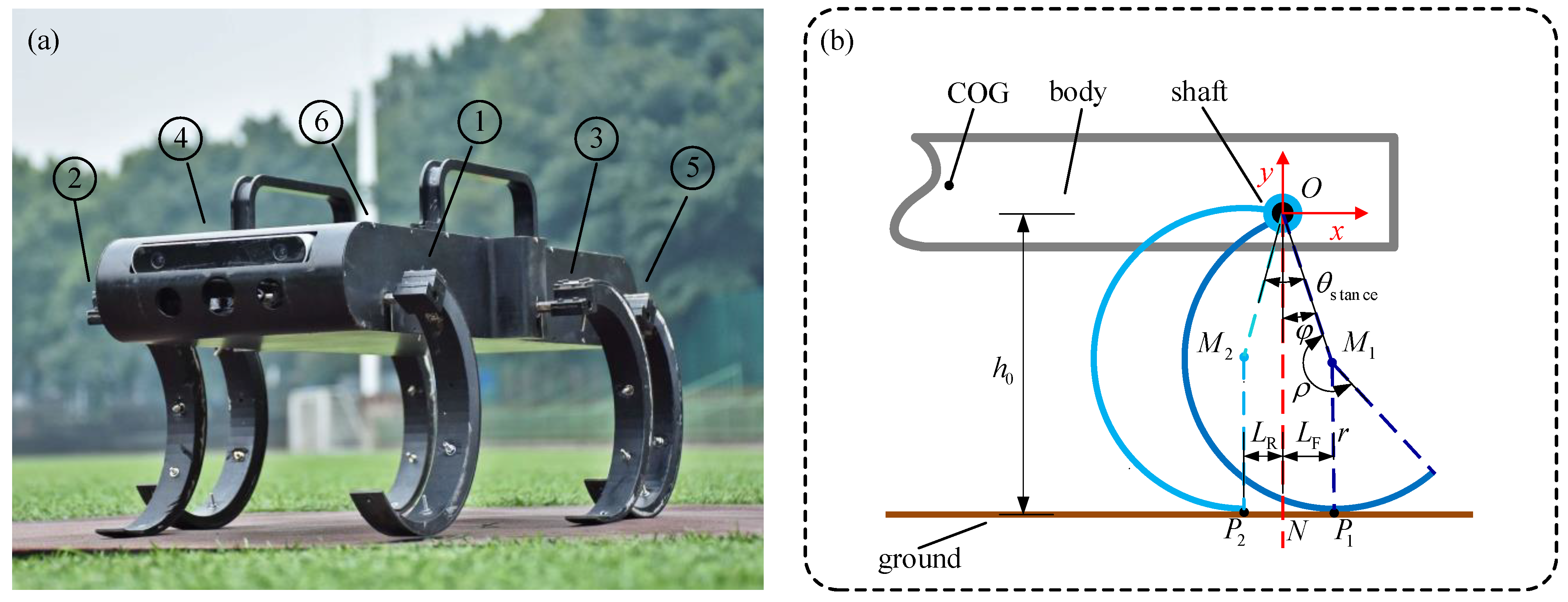


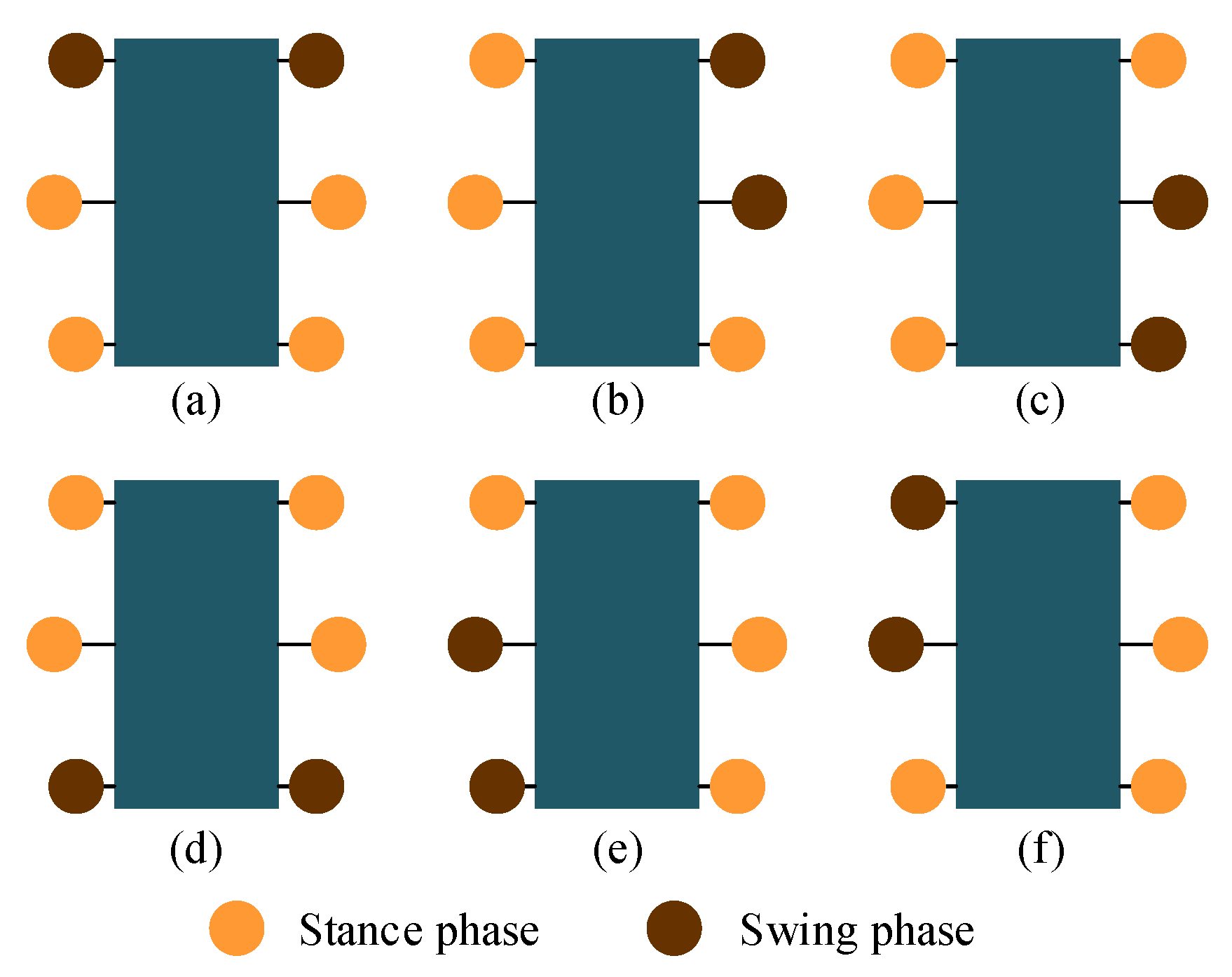
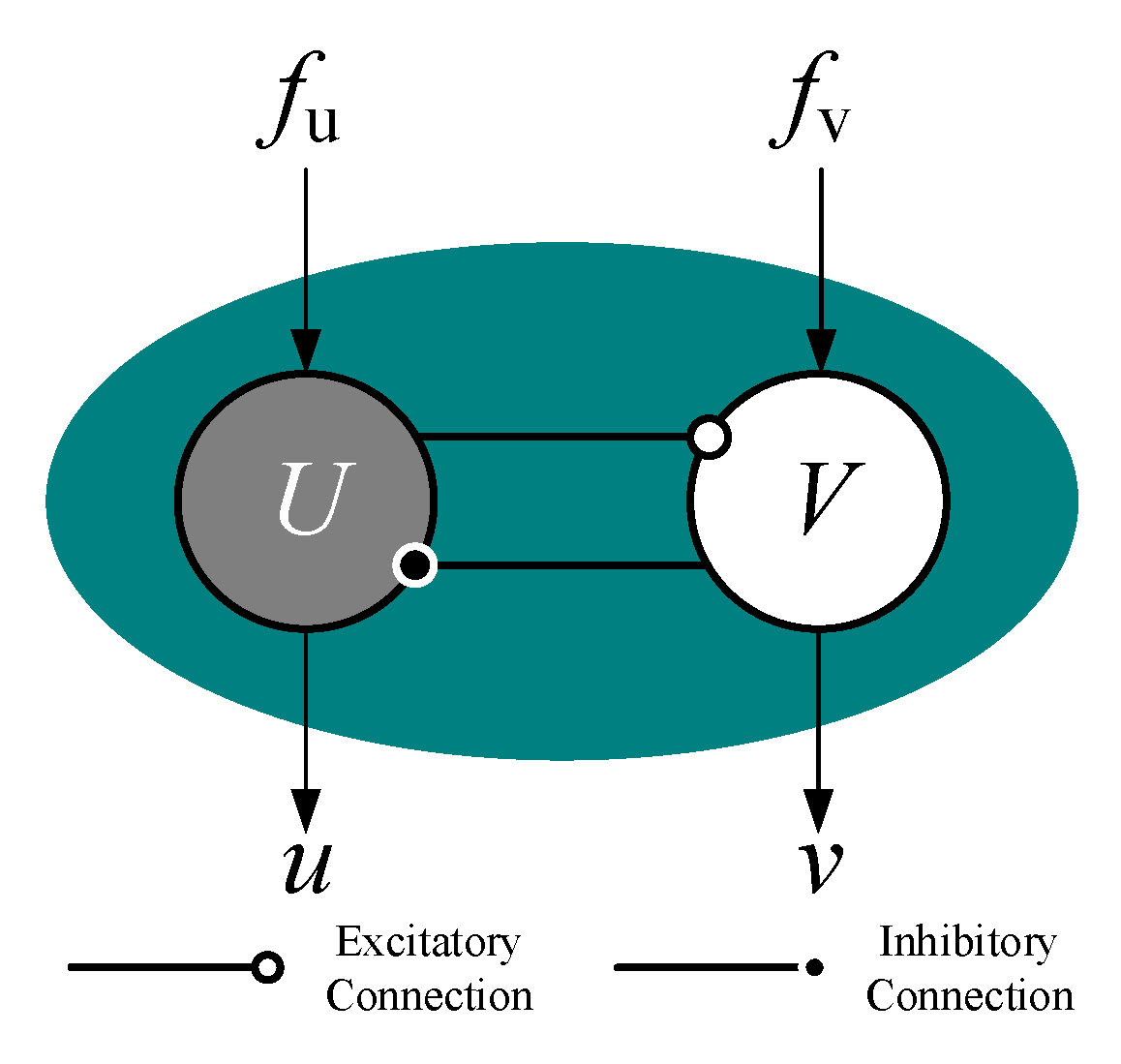

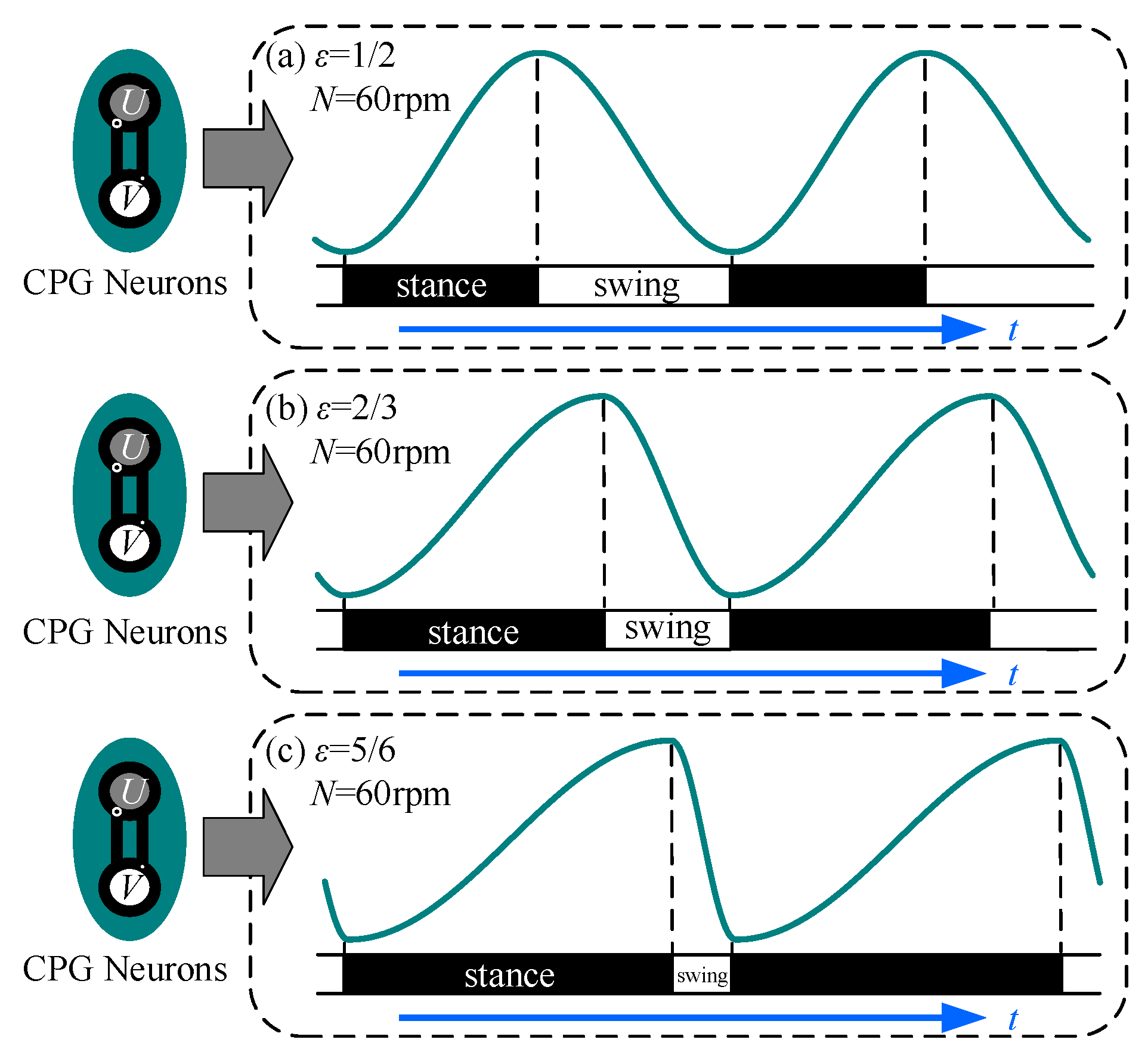
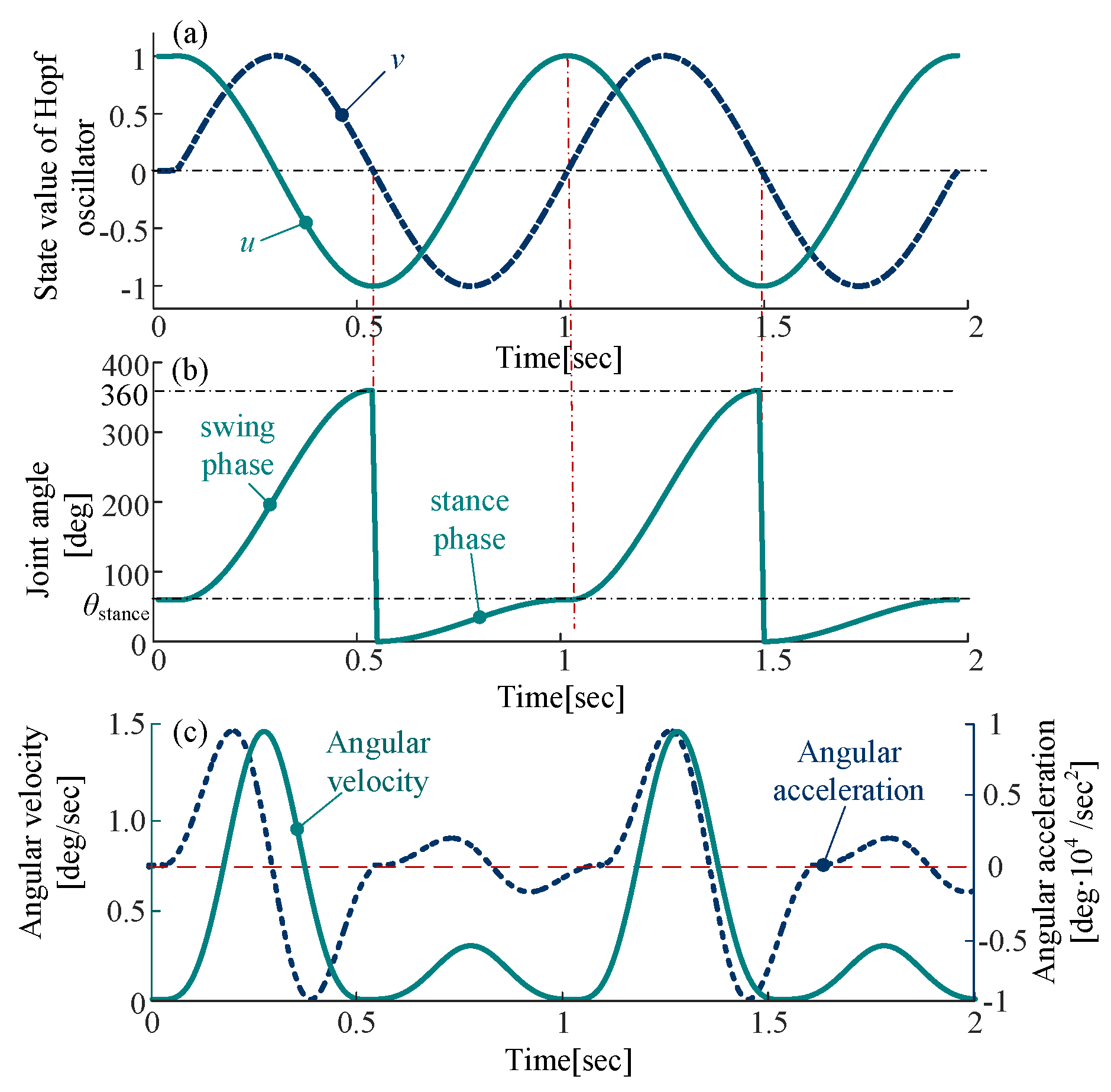
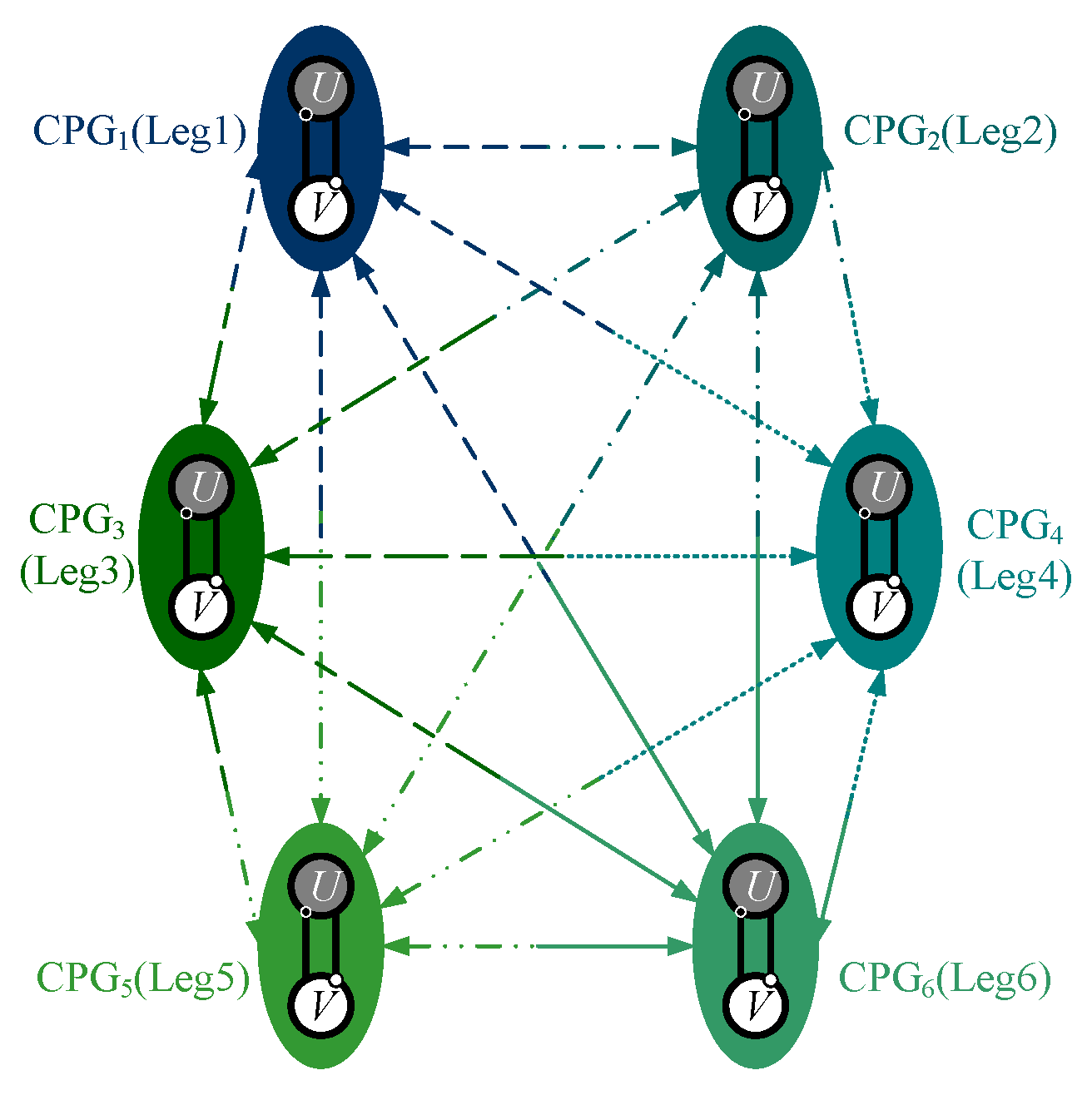
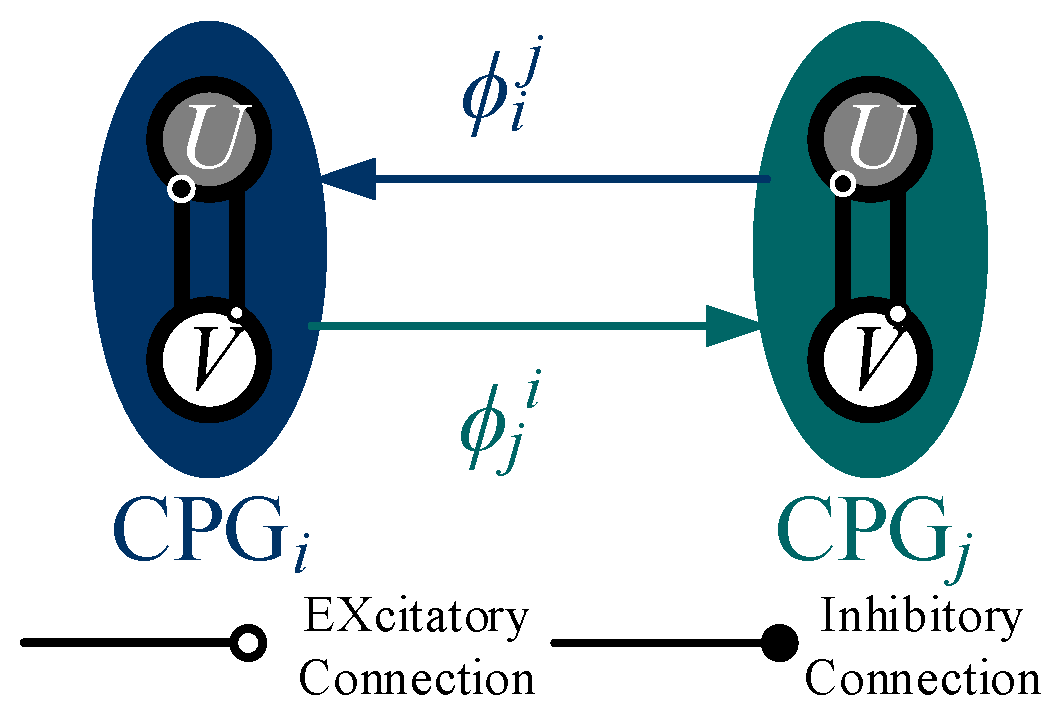
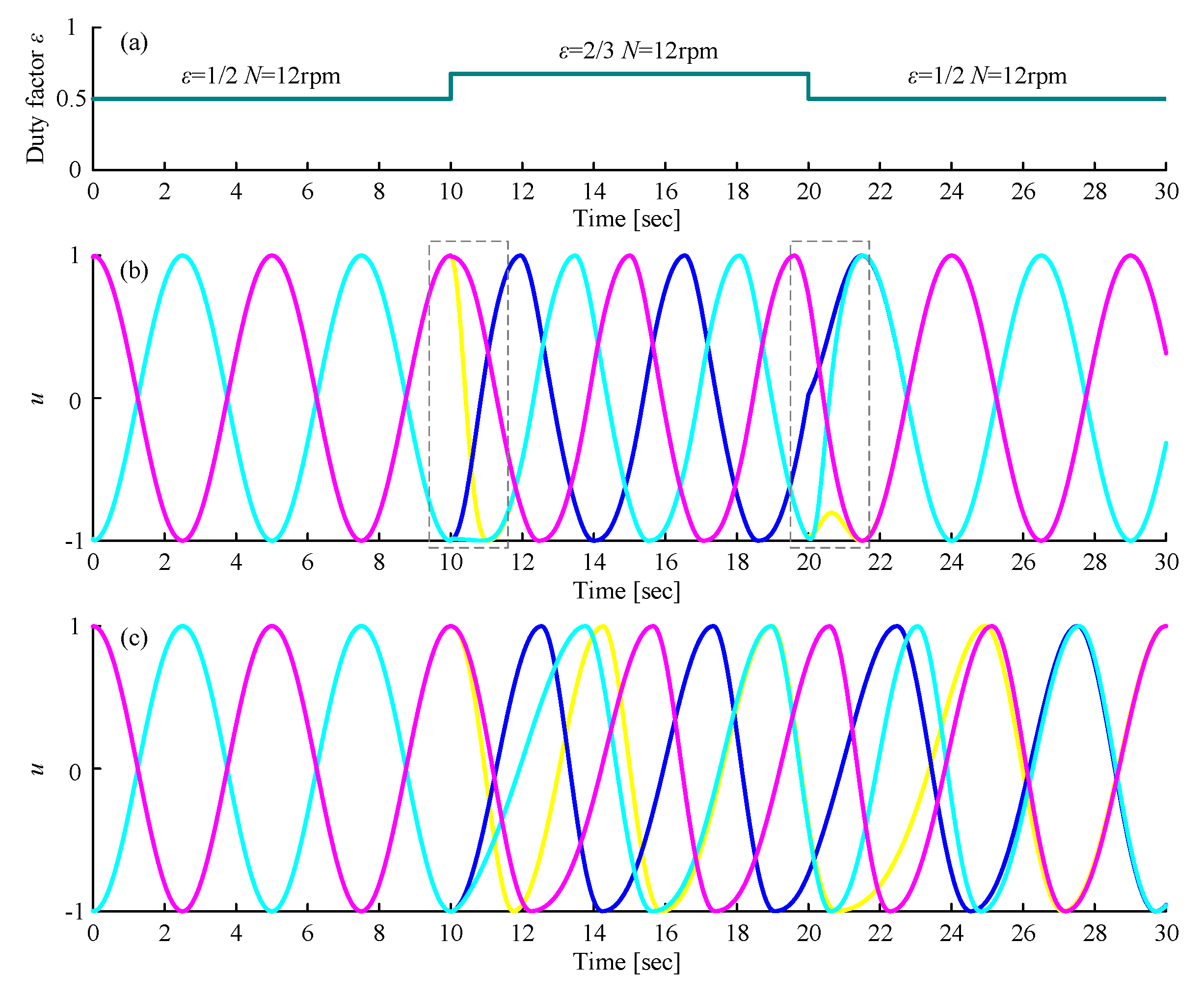
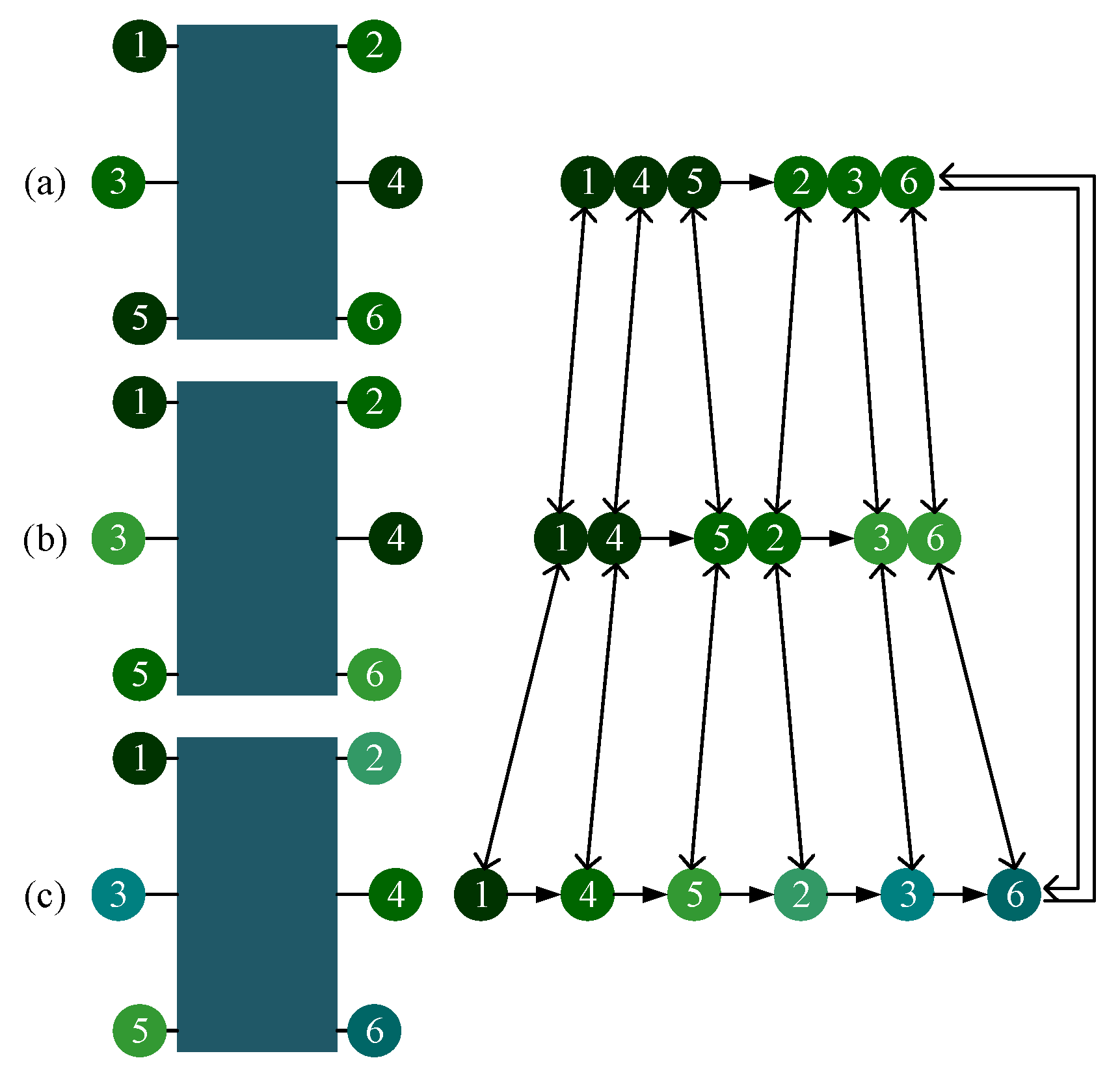



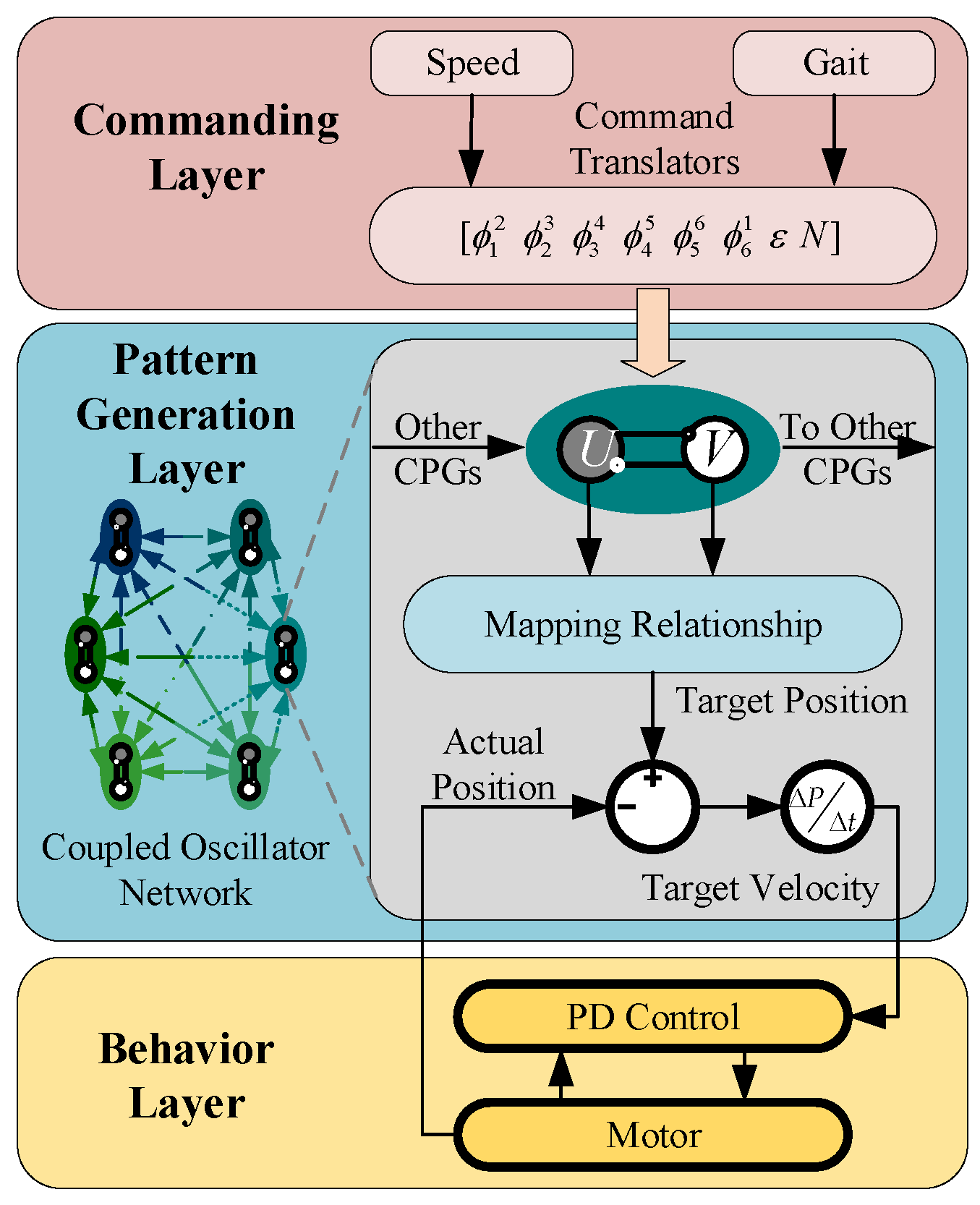
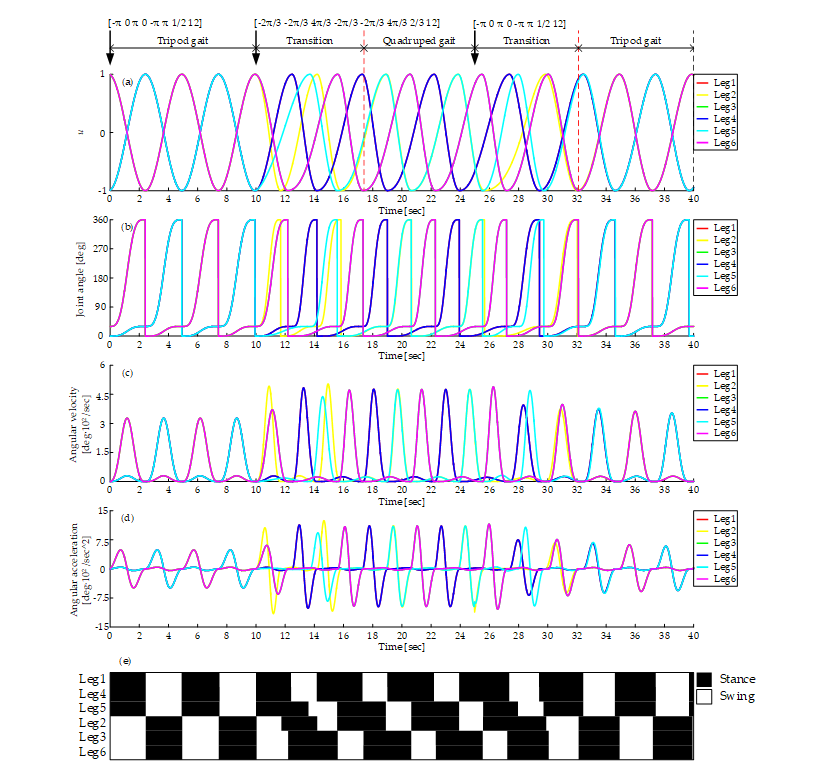
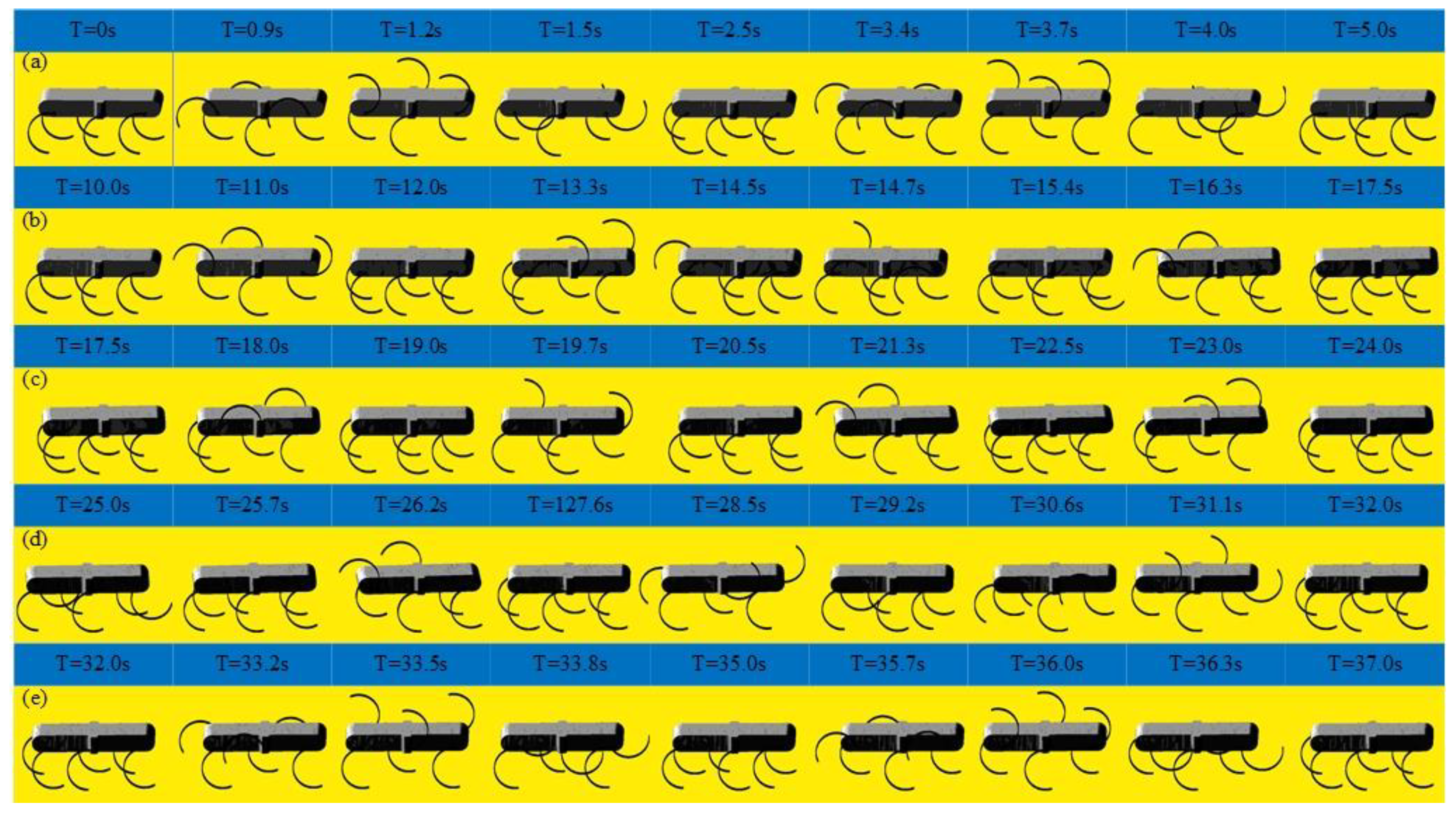
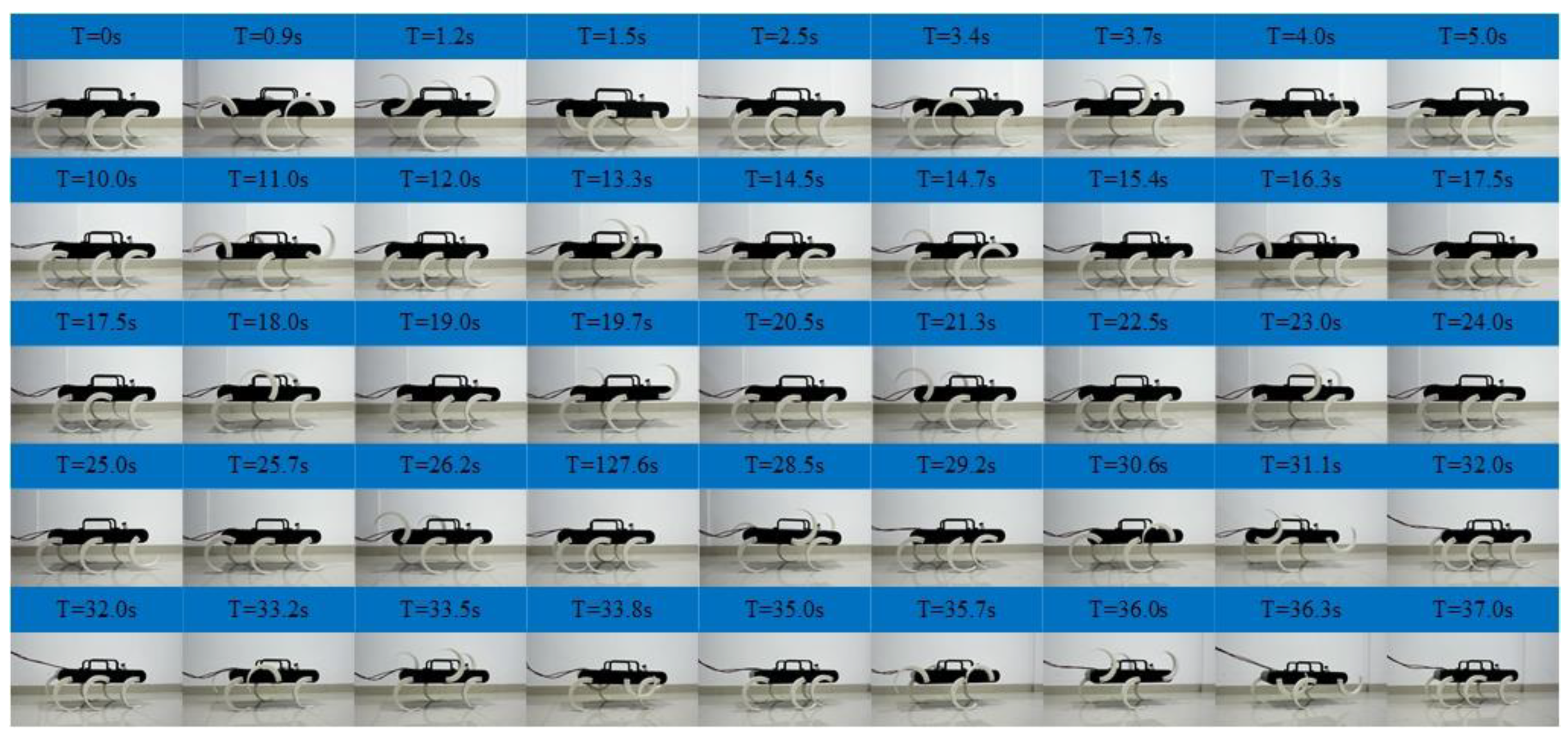
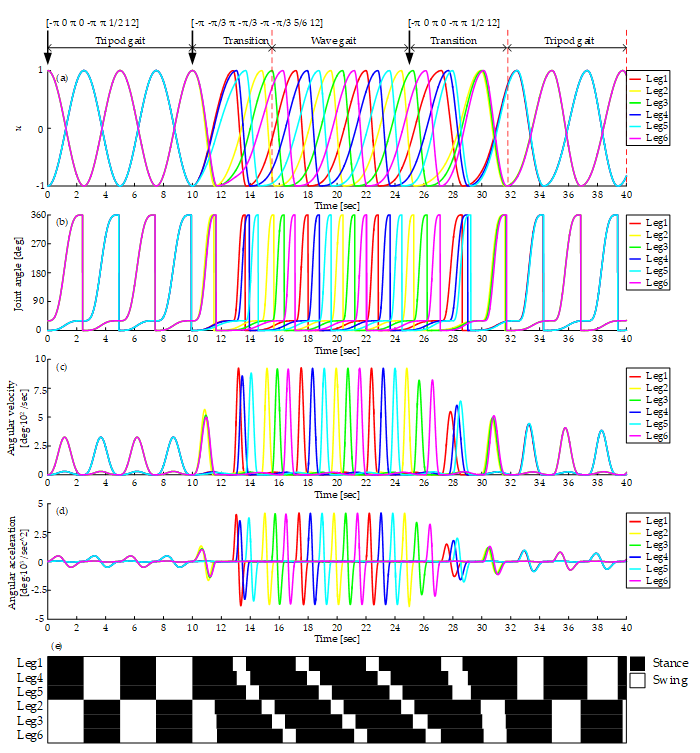
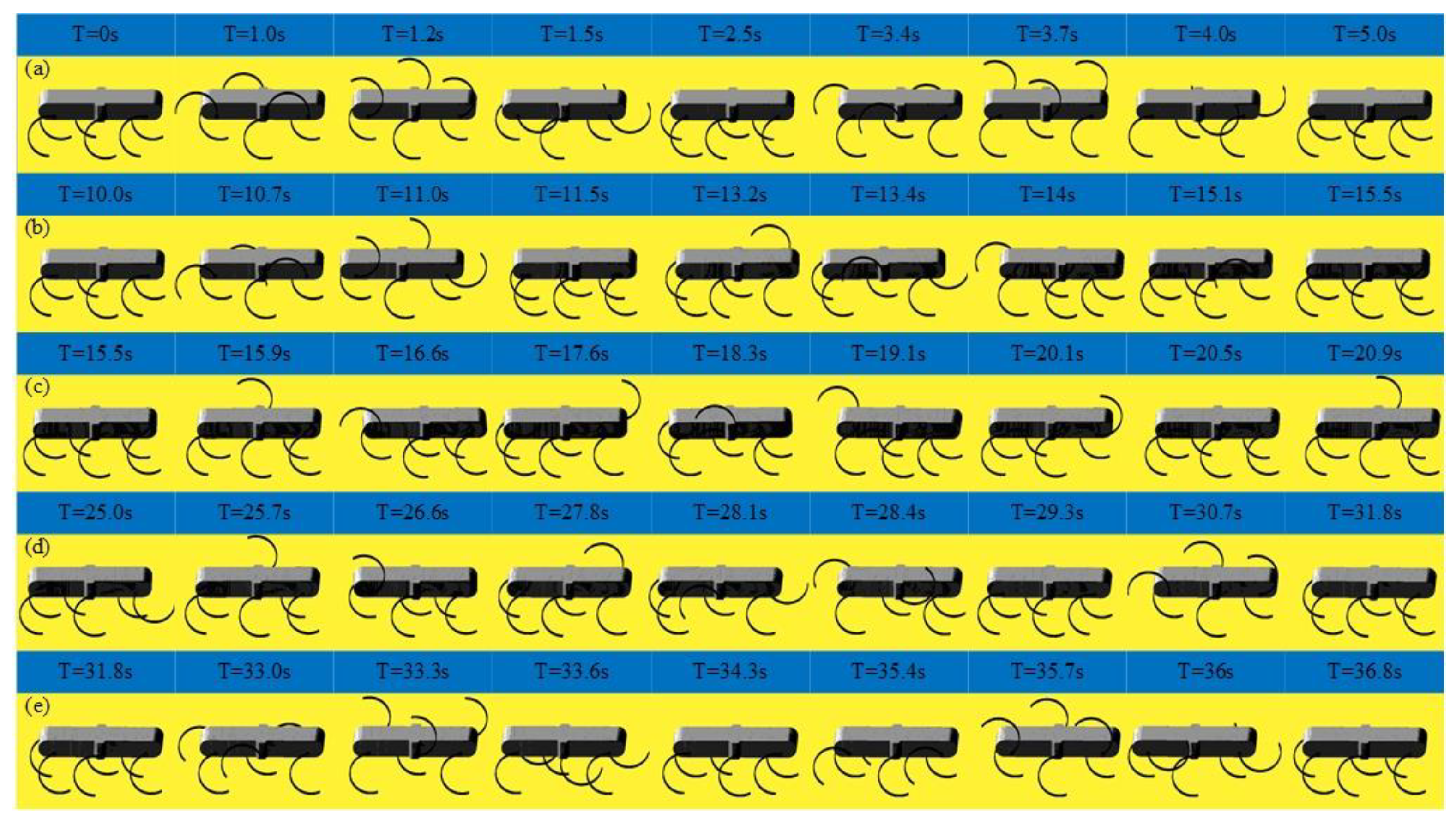
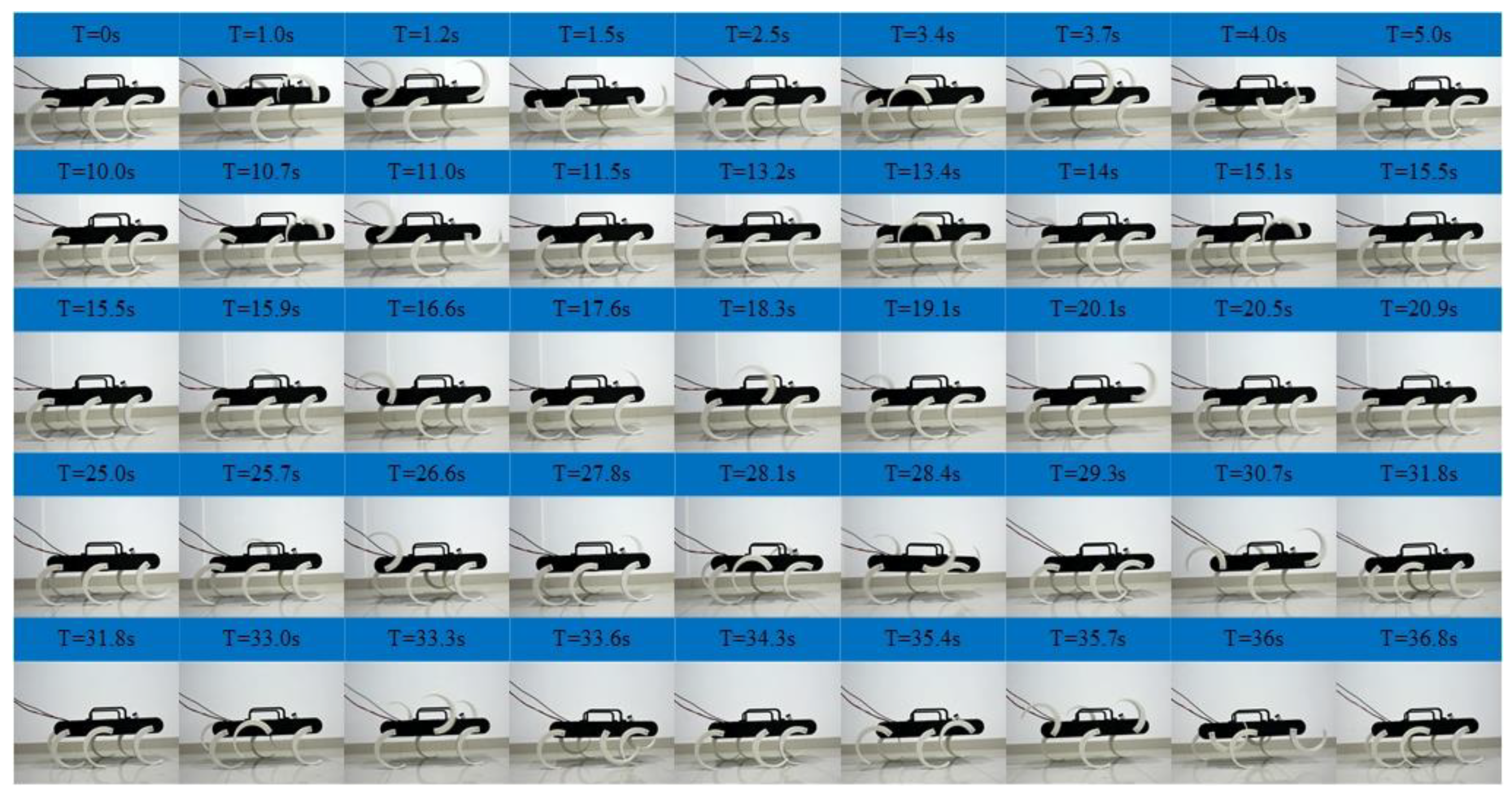
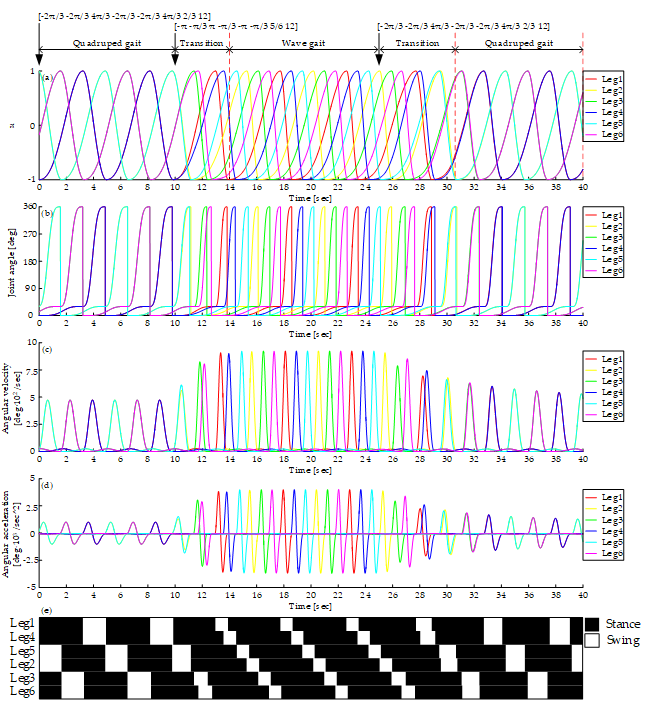
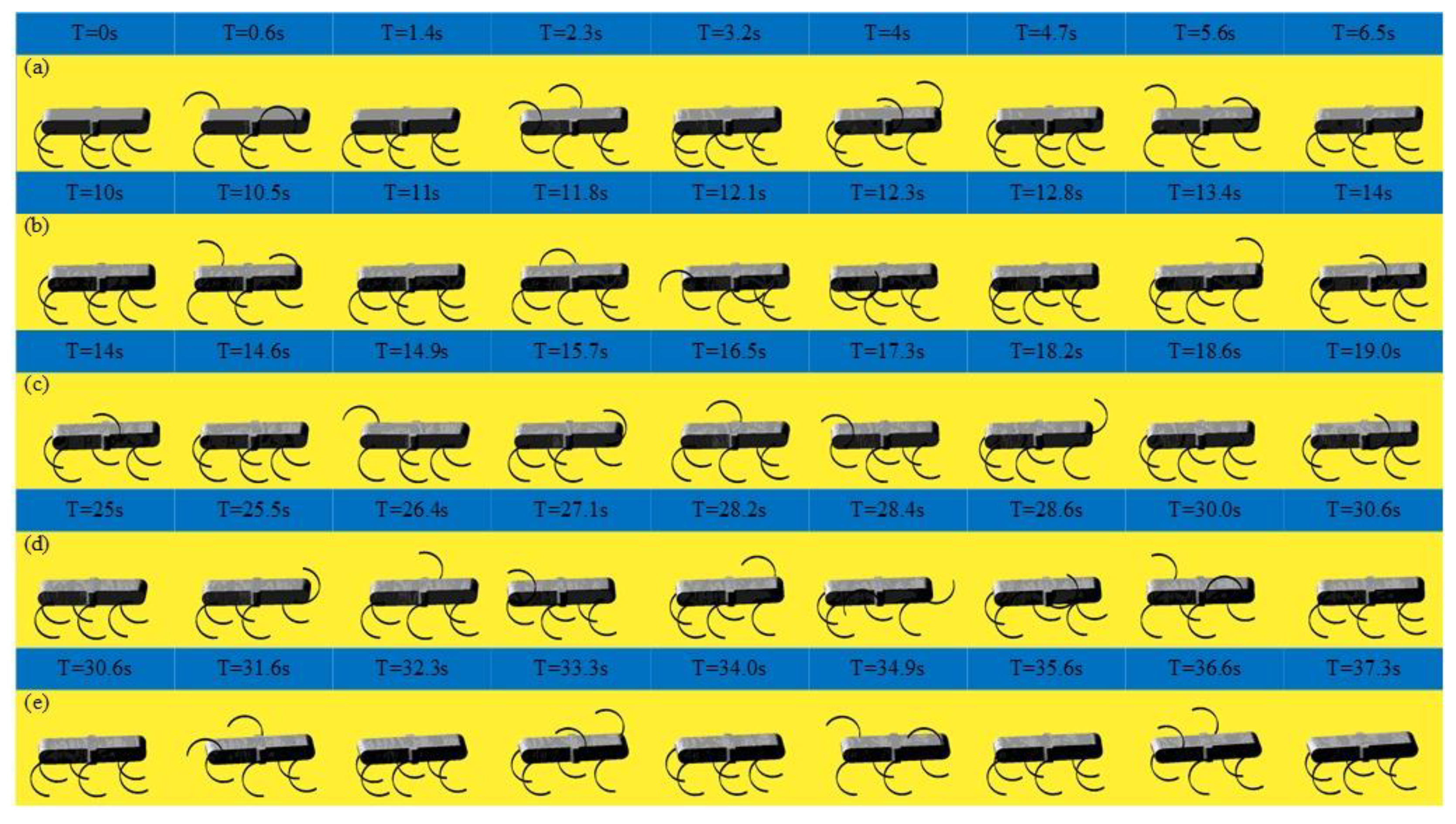
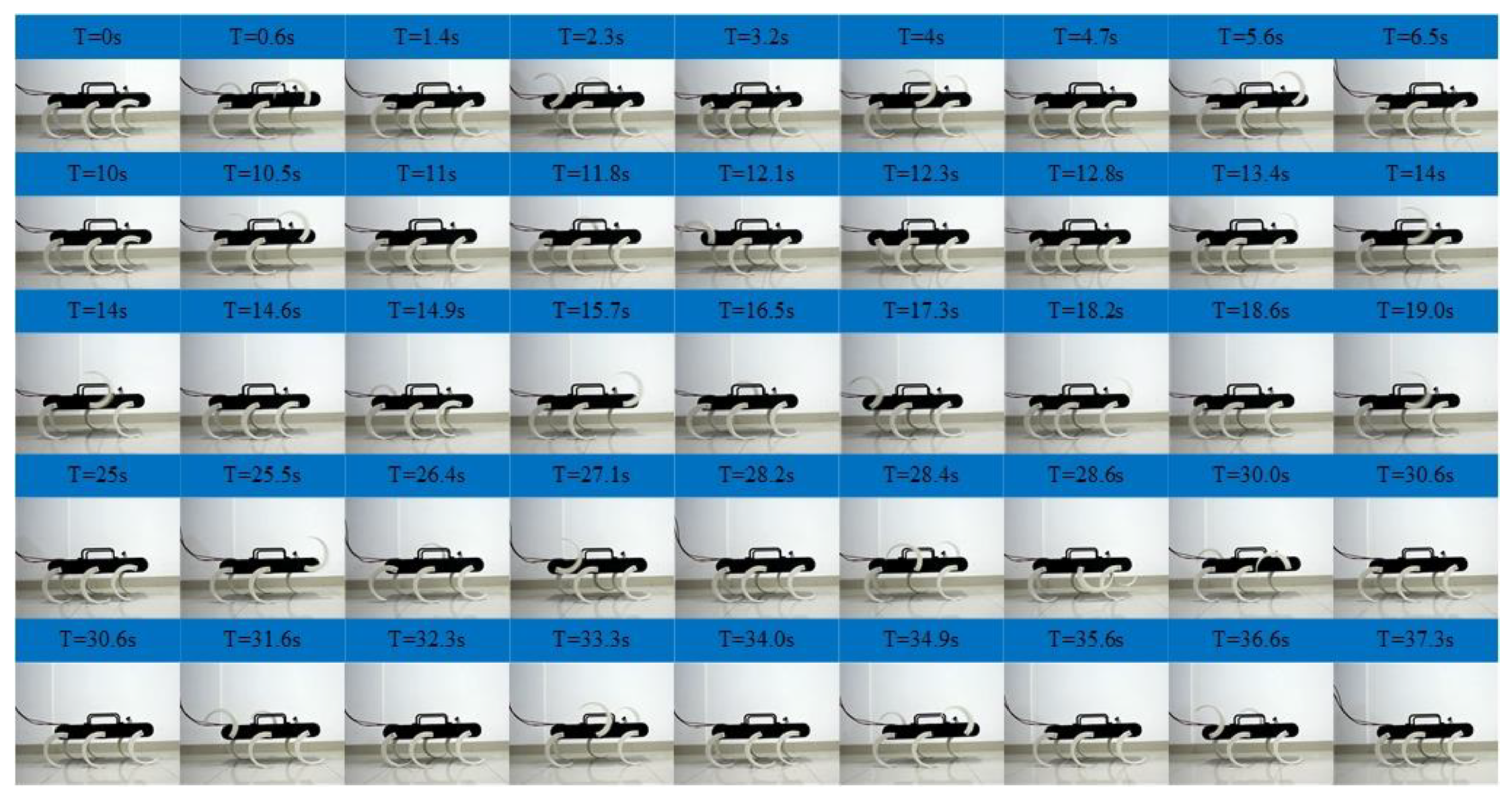
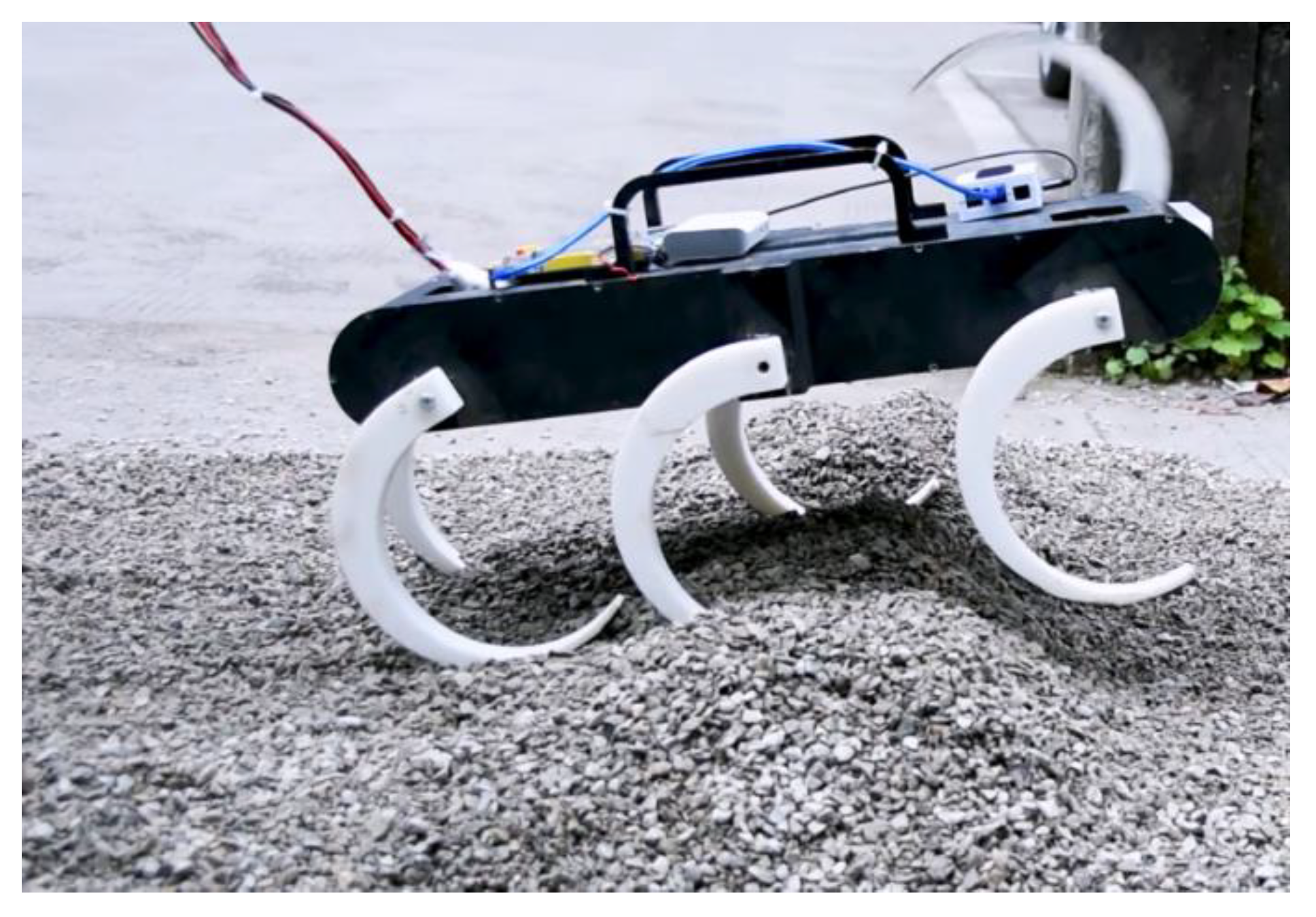
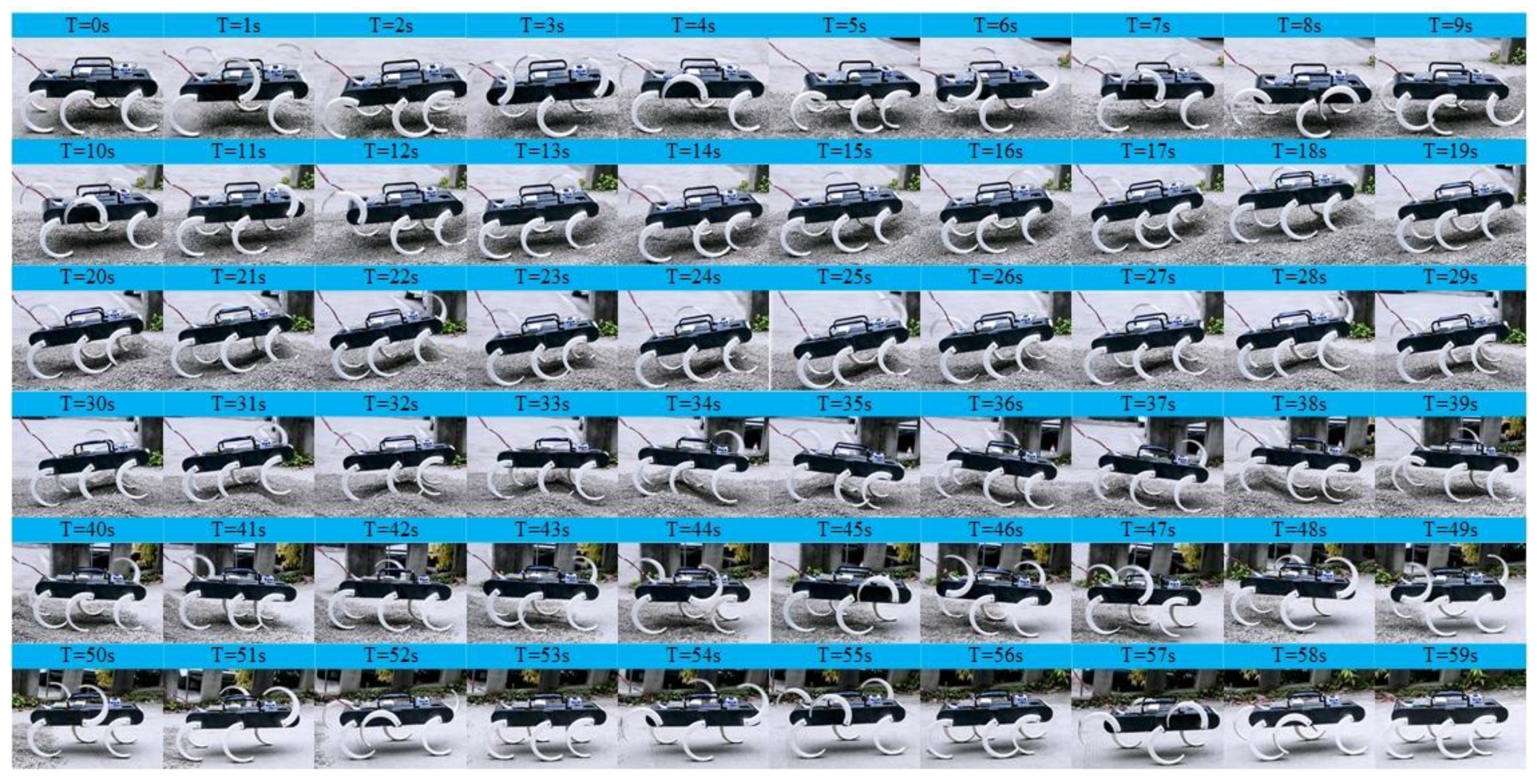
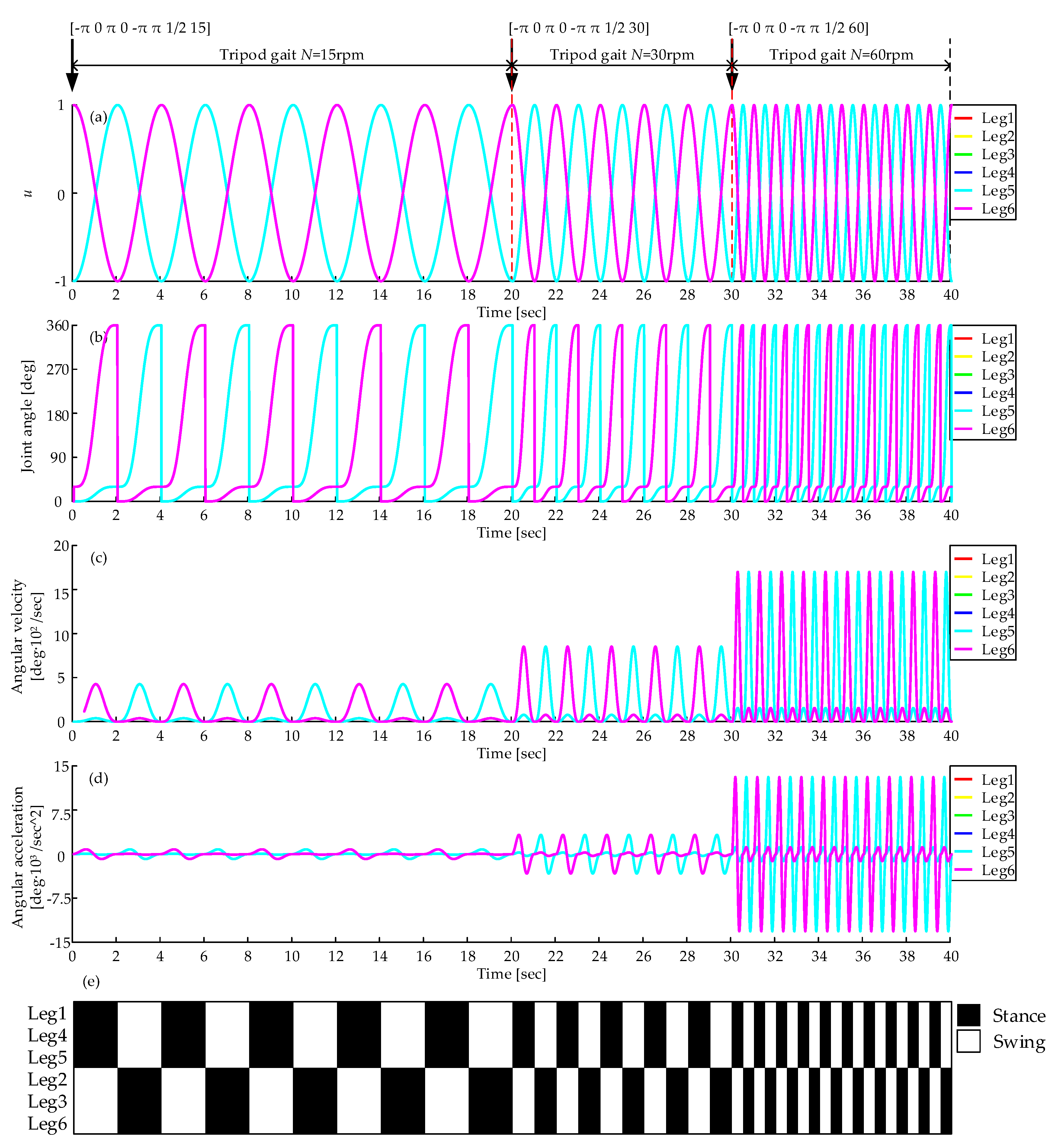
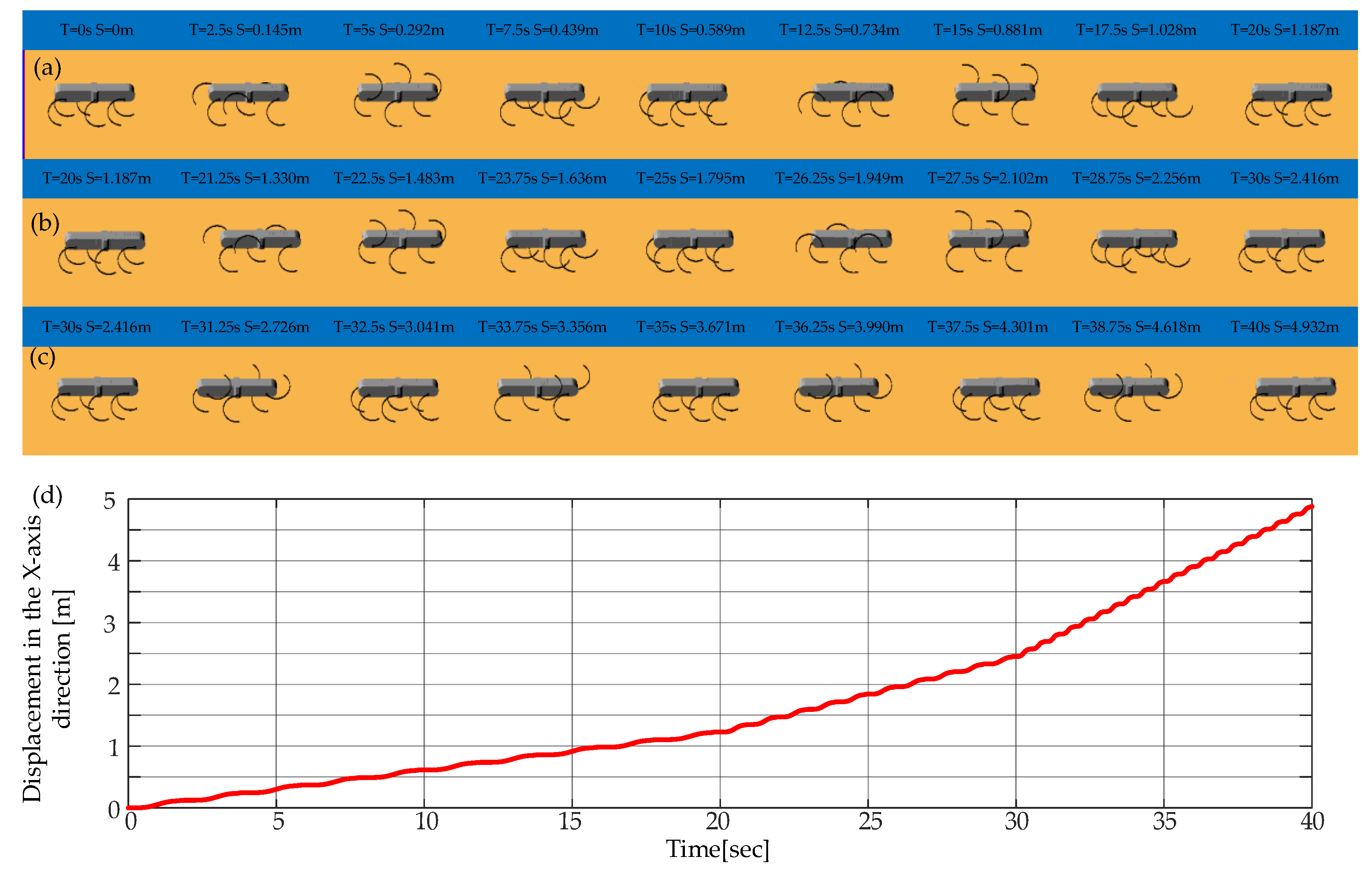

| Name | Wn (mm) | Wb (mm) | D (mm) | R (mm) | Ρ (mm) |
|---|---|---|---|---|---|
| Value | 280 | 320 | 230 | 110 | 210 |
| Distance | ||||||
|---|---|---|---|---|---|---|
| Value (mm) | 93 | 140 | 93 | 140 | 93 | 93 |
| Distance | ||||||||||||
|---|---|---|---|---|---|---|---|---|---|---|---|---|
| Value (mm) | 230 | 159 | 93 | 140 | 93 | 159 | 140 | 159 | 93 | 93 | 159 | 230 |
© 2019 by the authors. Licensee MDPI, Basel, Switzerland. This article is an open access article distributed under the terms and conditions of the Creative Commons Attribution (CC BY) license (http://creativecommons.org/licenses/by/4.0/).
Share and Cite
Bai, L.; Hu, H.; Chen, X.; Sun, Y.; Ma, C.; Zhong, Y. CPG-Based Gait Generation of the Curved-Leg Hexapod Robot with Smooth Gait Transition. Sensors 2019, 19, 3705. https://doi.org/10.3390/s19173705
Bai L, Hu H, Chen X, Sun Y, Ma C, Zhong Y. CPG-Based Gait Generation of the Curved-Leg Hexapod Robot with Smooth Gait Transition. Sensors. 2019; 19(17):3705. https://doi.org/10.3390/s19173705
Chicago/Turabian StyleBai, Long, Hao Hu, Xiaohong Chen, Yuanxi Sun, Chaoyang Ma, and Yuanhong Zhong. 2019. "CPG-Based Gait Generation of the Curved-Leg Hexapod Robot with Smooth Gait Transition" Sensors 19, no. 17: 3705. https://doi.org/10.3390/s19173705
APA StyleBai, L., Hu, H., Chen, X., Sun, Y., Ma, C., & Zhong, Y. (2019). CPG-Based Gait Generation of the Curved-Leg Hexapod Robot with Smooth Gait Transition. Sensors, 19(17), 3705. https://doi.org/10.3390/s19173705








